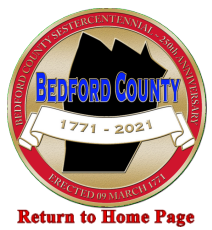
Hispanic~American Day
5 May 2021

The American Community Survey, compiled between 2008 and 2012 and being the most recent analysis, identified 1.2% of the total population of Bedford County as descending from Hispanic and Latino ancestors.
Known by the Spanish words for the day and month on which it occurs, this holiday is known as Cinco de Mayo. Cinco de Mayo is not, as many people believe, a holiday that celebrates Mexico's independence. Rather, it celebrates the victory of the Mexican Army under Ignacio Zaragoza over the French army under Charles de Lorencez on 5 May 1862. The French army was attempting to overthrow Mexican President Benito Juarez for Napoleon III. The battle took place at Puebla within seventy miles of Mexico City. Despite the fact that the conflict continued for two more years, at which time Napoleon's forces captured the Mexican capitol, the Battle of Puebla on Cinco de Mayo raised the spirits of the Mexican patriots.
Cinco de Mayo began twenty-two days after the actual event with the celebration of Mexican miners in California over their excitement on hearing the news of the victory of the Mexican Army. In the following year of 1863, the celebration was held in Sonora, California, but this time it was actually held on the 5th of May. The celebration spread to other locations in California and then throughout the country. Even to the present time, the United States celebrates this day as an unofficial holiday, but Mexico on the whole does not. Certain Mexican states, including Puebla and Veracruz hold reenactments of the battle. The 'holiday' gained popularity in the 1980s when beer and liquor companies saw the potential of high sales.
Entertainment at Cinco de Mayo celebrations is often provided by mariachi bands whose members are dressed in the traditional outfit known as traje de charro, referring to the clothing of the charro horsemen. The charro suit consists of sequin (or beaded) decorated tight pants, and a similarly decorated short jacket over a shirt and vest. The wide brimmed sombrero completes the outfit. Women performers wear the charra, a variation of the charro suit, with a long skirt substituting for the pants.
During Cinco de Mayo, Mexican restaurants throughout the United States host parties of revelers drinking tequila and lime margaritas. Typical 'Mexican' foods, of which most Hispanic~Americans are familiar such as tacos, burritos, quesadillas and enchiladas are common fare during the celebrations. There are a few basic dishes that are typically 'Mexican' cuisine, and they vary according to whether they are 'street food' or meat, egg or cheese dishes. The word 'street food' is given to the type of foods which can be held in the hand and be easily eaten while on the move. They tend to include dishes such as Tacos which can be soft or hard. Soft tacos consist of a meat, such as shredded chicken or beef, shredded cheese, shredded lettuce and a chile-based sauce wrapped in a flour tortilla or very thin, flat pancake. Hard tacos contain the same ingredients as the soft taco, but the tortilla is made of cornmeal and pressed into a 'U' shape to hold those ingredients. A Burrito consists of a flour tortilla wrapped around various ingredients that differ slightly from the soft taco. Usually a burrito will contain the meat, either chicken or beef, and the cheese, but additionally they might include tomatoes, beans, rice, salsa, guacamole and/or sour cream. A burrito might be grilled or steamed. A Chimichanga is basically a burrito which is deep fried rather than steamed or grilled. Enchiladas are corn tortillas wrapped around a meat (such as shredded chicken or beef) and cheese similar to a burrito but without the lettuce, and which are topped with chile-based sauces. The Quesadilla consists of a flour tortilla folded over on itself into which are inserted mostly cheese, but also some meat and perhaps beans. Tamales are corn tortillas wrapped around one of the meats, cheese, vegetables or fruits and chiles, all of which is then wrapped in a corn husk or banana leaf and then roasted. The corn husk or banana leaf serves as a 'plate' when the dish is ready. A corn tortilla that is toasted or fried in oil that may be eaten as such or as a scoop to pick up other foods, such as refried beans is a Tostada. Anyone who eats at 'Mexican' fast-food restaurants will know what a Nacho is. It is a corn tortilla that is rolled very thin and then roasted to form corn chips. Nachos are generally covered with melted cheese sauce along with chiles or salsa. Utilizing a cornmeal tortilla as a 'plate', mashed pinto beans are spread across the tortilla and topped by white cheese or other toppings to make a Huarache. Chalupas consist of cornmeal dough pressed into a bowl shape and then deep-fried to create an edible dish into which combinations of the shredded meats, shredded cheese, refried beans, salsa and shredded lettuce are added. In the United States, for the benefit of consumers who may not be familiar with the proper Hispanic name for the dish, the chalupa is commonly and simply called a Taco Bowl.
The meat, egg and cheese dishes include Carne Asada which is a grilled steak which is seared to impart a charred flavor. Milanesas can be either beef, chicken or pork that are breaded and then fried. Huevos Rancheros are fried eggs laid on a slightly charred tortilla (either corn or flour) and topped with a mixture of diced tomatoes, onions, chile peppers and cilantro. Huevos Motulenos are eggs on tortillas and topped with black beans and cheese. A popular cheese dish is Queso Flameado which is a sort of cheese fondue served flambe by pouring some alcohol on the dish and setting it aflame just before serving it.
Guacamole, salsa and sour cream are scooped up in great quantities using Tortillas in the form of corn chips (i.e. nachos). Guacamole is made by mixing lime juice, cilantro and jalapenos with mashed avocados. The word Salsa refers to any type of sauce. The type of salsa most commonly eaten in the United States is tomato and chile-based Pico de gallo.
Perhaps the most popular dessert choice is Flan, a custard covered with clear caramel. The dish is prepared in a bain-marie, or water bath. The caramel is made by cooking sugar syrup until it turns into a golden colored syrup. The caramel is poured into a mold and custard made with sweetened milk or cream and egg sometimes mixed with a bit of flour or gelatin. The custard is added to the mold in which the caramel was poured. The whole is heated gently in the bain-marie until the custard is solid. The mold is then turned over and the Flan slides out with the caramel on the top. Sopaipilla is a type of fried pastry. Leavened wheat dough, to which a shortening agent, such as butter, has been added is rolled out flat. Square, triangular or round shapes are cut out of the dough and then deep-fried in oil. Some sopaipilla are cut twice as long as intended in order for them to be folded over on themselves to form pockets into which various fillings are inserted. Whether filled or flat, the sopaipilla, fresh out of the fryer, may be dusted with sugar or cinnamon. One of the more unusual desserts is Fried Ice-cream, which may not have originated in Hispanic cultures, but which has become a 'Mexican' restaurant favorite. A scoop of ice-cream is frozen solid and then rolled in some type of batter. It is then quickly deep-fried which solidifies the coating before the ice-cream can melt. The fried ice-cream is then given a topping of either chocolate syrup or caramel.
Additional Information Might Be Added Here. Please Check Back.
Click on this logo to return to the Calendar page.

